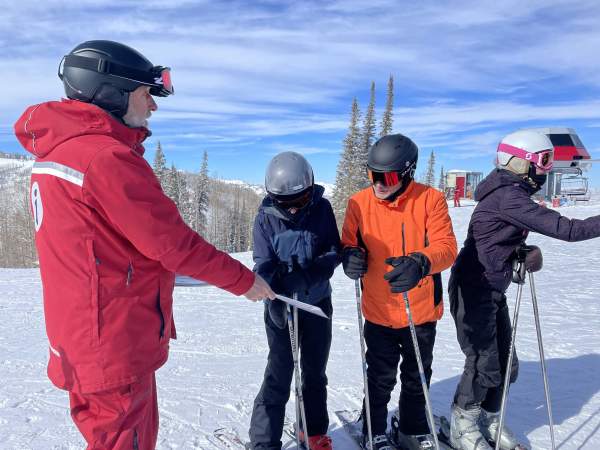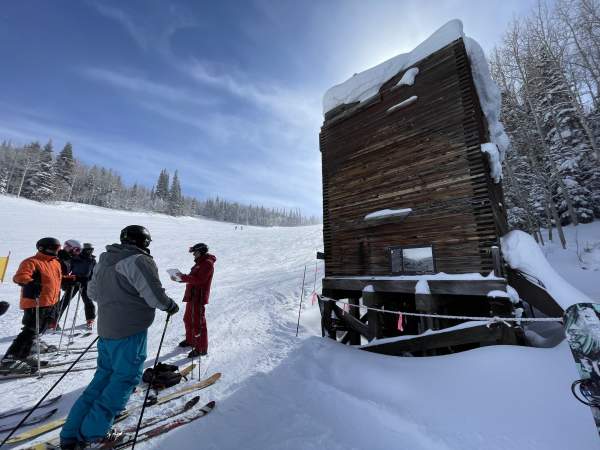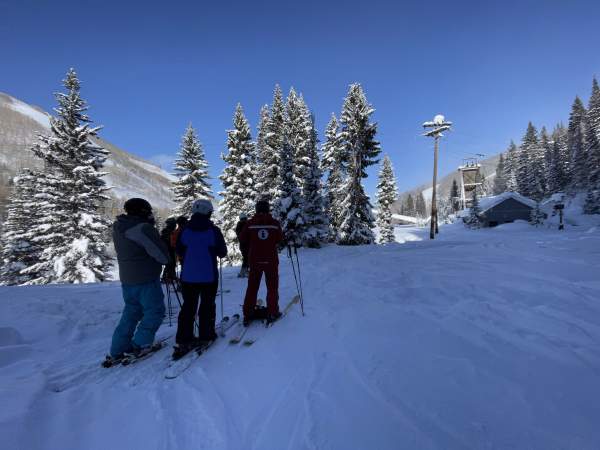Ski enthusiasts and history buffs rejoice! The well-loved Silver to Slopes Historic Mining Ski Tour has been brought back to Park City Mountain after a hiatus during COVID. On this two-hour tour of Park City’s mining relics, you can combine your love for skiing and history and enjoy diving into the past of our mining-turned-ski town.
If you didn’t already know, Park City was a mining town before it became a ski town and we have the historic reminders to prove it! Scattered around PCMR you’ll find shadows of the past, preserved history, that you can ski to and see how Park City became a desirable spot on the map. This free, guided, intermediate-level ski tour takes you on a fun yet educational journey to historic buildings where your expert guide will share stories that will unlock secrets of yore and help you dive deeper into Park City’s rich mining, skiing and local history.
Led by the men and women in red, Park City’s Mountain Service Guides, you can catch the tour at two times 7 days a week. The morning tour meets at 10 AM at the Eagle Statue and the afternoon tour meets at 1 PM at the large trail map at the top of the Bonanza Chair Lift. But make sure to sign up at the Guest Service Desk in the Legacy Lodge as there are only 10 spots available on each tour.
- Details
- What: Silver to Slopes Historic Mining Ski Tour
- Where: Park City Mountain
- When: 10 AM and 1 PM
- Who: Intermediate Skiers interested in learning about Park City’s Mining History
Experience
Excited to learn about all the historic mining artifacts on the slopes of Park City, before heading up the mountain for my ski day I signed up for this free tour in the Legacy Lodge right at the base of Park City Mountain by the Payday Chairlift. At 1 PM I met the other history buffs in front of the large trail map at the top of the Bonanza Lift. The group I was joining was so excited to be heading out on this tour, and it wasn’t their first time! They mentioned that they love learning new tidbits from the different guides they’ve had, and they always bring along friends who are visiting as it is a great way to learn your way around Park City Mountain and to be educated on how PCMR came to be.

Our Mountain Host Guide was Sandy Brumley, a history buff, an aspiring screenwriter, and a volunteer for the Friends of Ski Mountain Mining History (FSMMH), a local nonprofit preserving Park City's unique on mountain mining history for future generations. He gathered our group and gave us our first talk about the history of Park City and its on mountain structures.
Stop 1: The Summit House
Sandy pulled out some black and white photos of the area where we were currently standing, and we started our tour with a little bit of ski history. Our first structure that is on the tour is The Summit House, not quite a historic mining building, but an important step in Park City becoming a ski town. The original Summit House, gondola, and other chairlifts were built in 1963 when Treasure Mountain Ski Resort had the green light to open after a coalition of miners put together a proposition for the government to infuse money into the dying mining town of Park City, wanting to revitalize the West. Other chair lifts that were built were named after mines, like the King Con Lift, named after, you guessed it, the King Con mine. Many of the runs that you slide down are named after mining terms like these runs off of the Thaynes Chair, Double Jack and Single Jack, which refer to methods of hand drilling.

Stop 2: King Con Ore Bin
Our next stop is at the King Con Ore Bin on the Claimjumper run. This ore bin was part of a bigger mining complex and is the only remaining structure from the King Con Mine. There used to be an aerial tram in the area as well that would transport coal up to operate the mine and bring down the ore. The FSMMH recently restored this building in 2022, a two-year project ensuring this beautiful artifact will stand proudly for many years to come.

Stop 3: Mid-Mountain Lodge
After making our way up the Silverlode lift, we skied down by way of Jonesys’ to the Mid-Mountain Lodge, our third stop on the tour. Skiers and snowboarders can experience mining history by stopping in for a bite and a drink at the Lodge, which was built in 1897 as a boarding house and dining hall for miners. In its second calling, nearly 80 years later, it became a dorm for members of the U.S. Ski Team. The lodge was part of a dense complex of other buildings, including two additional bunkhouses that all served the Silver King Mine. The Mid-Mountain Lodge remained in use for another half-century by miners, though it was closed in 1953 as the value of silver declined. The structure was slated for demolition when a couple of Park City residents and Treasure Mountain resort owner Nick Badami stepped in to save it by moving the large structure 500 vertical feet up the mountain. So in 1987 seven bulldozers pushed and pulled the 140-ton building more than half-a-mile to its present location.

Stop 4: Kearns Keith Mill
We then cruised down past Mckonkeys Lift to the bottom of Pioneer, where a black and white placard stands showing a picture of the Kearns Keith Mill that used be in that spot from 1903 to 1998 when the crumbling structure was demolished. The Kearns Keith Mill was erected as an exact duplicate of part of the Silver King Mine, and was set up as an additional mining company to continue to leverage their assets. Lovers of Park City history were pretty upset when they learned of the plans to demolish this structure rather than restore it.
Stop 5: Thaynes Mine
As we continue on the tour, we ascend up Pioneer and meander down into Thaynes Canyon on Keystone. Sandy points out a couple of other interesting aspects off of the run (I don’t want to ruin the whole tour for you) and we end up at the Thaynes Mine, the very large structure you see beside the Thaynes Canyon lift. This is the Thaynes shaft, a western shaft of the Silver King Coalition Mine. As the Great Depression swept across the USA, metal prices plummeted nationwide and Park City’s mining economy struggled. In 1933, President Roosevelt announced the government would purchase domestically mined silver at a premium. The news prompted the Silver King Mining Company to dig a deep shaft to access the Spiro Tunnel 1,800 feet below and explore for ore bodies. The steel headframe, shaft house and headquarters were completed early in 1937. The shaft reached the Spiro Tunnel in May 1939 and provided access to new ore, while helping ventilate some of the old working areas. Sinking the shaft, however, created vast quantities of waste rock. Needing to remove this overburdened material quickly and inexpensively, a long wooden conveyor was installed to carry the rock away, creating the enormous gray pile of rock just west of the shaft, that is currently covered in snow.
The mining equipment was resurrected from 1965 through 1969 as the world’s most unique ski lift. An electric motor pulled skiers in little carts through the Spiro Tunnel to the base of the Thaynes Shaft. Then the skiers were lifted up the 1800’ shaft to ski in Thaynes Canyon. It operated as a primary lift on windy days when the Gondola couldn't run. Today, the Spiro Tunnel is maintained by Park City Municipal because it is a major source of drinking water for the town. The conveyor is one of Park City's more unique mining structures, and the FSMMH were fearful that if one part of the conveyor fell over, the entire connected structure would follow in a domino effect, so they made it a priority to restore the structure which was completed in 2020. Currently, FSMMH is in the process of Saving the Thaynes Headframe Complex and their goal is to complete the stabilization and restoration work by 2027 which is dependent on raising at least $3 million during their capital campaign. They will then offer guided tours of the complex.

Stop 6: Silver King Mine
The last stop of the tour was right on the horizon as we slowly sailed up the two-seater lift, one of my personal favorites at Park City Mountain Resort. We reconvened at the top of Thaynes and skied to the Silver King Mine, past the Summit House, down Bonanza to where the looming structure stands. The Silver King Shaft House, at the base of Bonanza Lift, closed in 1953 when metal prices were too low to produce a profit. The historic building contains the shaft, headframe and hoisting works, including the powerful engines for lifting the cages. In its heyday, the Silver King Mine was one of the “Big Three”, and was the second discovery that would make Park City one of the world’s most profitable mining camps of its era.
Conclusion
Being able to ski to such significant Park City relics is not only fun but also educational, and the snow currently is of historic proportions, so that is an added bonus!
This is only a fraction of what you’ll hear on the tour, as I’ve only shared minor tidbits of the stories and facts Sandy shared with our group. There is so much information about the mining history of Park City, the people who settled the area and created claims, and the structures that have been demolished and are currently being restored. There are endless backstories, and depending on which guide you get, you could get different stories, tales, and facts. So if you do decide to take the tour multiple times, you will always be surprised by your guide's take on the history of Park City Mountain’s mining history.







